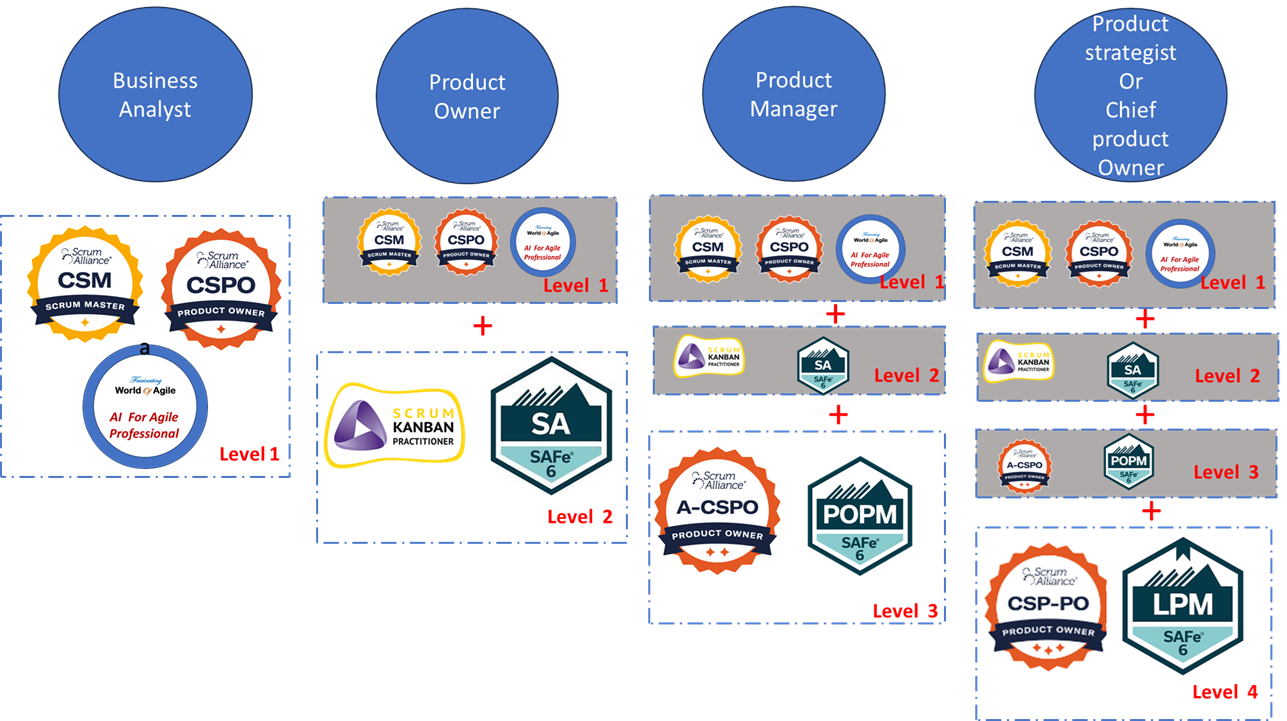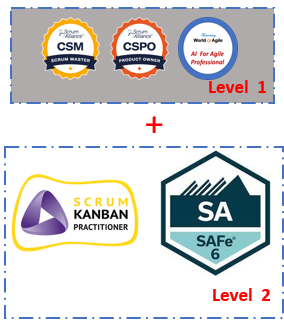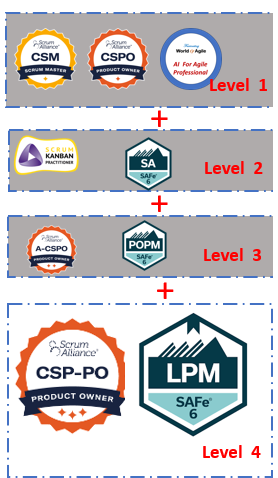Career Track for a Product Owner: FAQs
Generic Questions
Question: What’s the main difference between a Product Owner and a Business Analyst?
Answer: A Business Analyst (BA) focuses on understanding business needs and documenting requirements, which they then translate into user stories or acceptance criteria. In contrast, a Product Owner (PO) is responsible for prioritizing these requirements to ensure the team delivers maximum value. While both roles work closely with stakeholders, the PO holds the ultimate accountability for the product’s success. A Business Analst role is often a steppingstone for a career as a Product Owner
Transitioning into a Product Owner Role
Question: Can a Business Analyst transition into a Product Owner role?
Answer: Yes, many Business Analysts successfully transition into the Product Owner role. BAs already have a strong foundation in understanding requirements and managing stakeholders. They can gradually take on more responsibility by gaining experience in backlog management, prioritization, and Agile frameworks. Pursuing certifications and finding a mentor can further support this career progression.
Question: How much experience is needed to become a Product Owner?
Answer: A typical Product Owner position requires 2 to 10 years of experience, though this can vary depending on the industry and product complexity. Experience working with Agile teams and understanding the software development lifecycle is highly valued. Even early-career professionals can enter this role if they have relevant certifications and practical exposure.
Key Skills and Professional Growth
Question: Why should a Product Owner learn about Kanban?
Answer: Learning Kanban helps a Product Owner visualize the workflow, spot bottlenecks, and continually improve processes. It complements Scrum by offering flexibility in managing tasks and focusing on optimizing throughput without overwhelming the team. Understanding Kanban allows a PO to balance the team’s workload, boost efficiency, and quickly adapt to changing priorities.
Question: Why should a Product Owner do both Scrum Alliance A-CSPO and SAFe POPM?
Answer: Combining Certified Scrum Product Owner (A-CSPO) and the SAFe Product Owner/Product Manager (POPM) certifications enablers a product owner to showcase both breadth and depth of the role. A-CSPO focuses on strategy budgeting and governance of a single product, while POPM is designed to teach how to be the Product Owner for a large product with multiple team. Getting both shows you can manage entire product development lifecycle from Strategy to execution in both small, focused teams and large, complex organizations.
Question: Why should a Product Owner get a CSM certification?
Answer: While a PO is focused on the product, a Certified Scrum Master (CSM) certification is valuable because it provides a broader understanding of how Scrum works. CSPO as a certificate focuses on product development and tactical management of product backlog. On the othet hand Scrum helps to understand how developers work together to deliver the items in the Product backlog. It gives a PO a better understanding of the team’s needs, which can help them facilitate smoother processes and become a more effective collaborator. Having both a product-focused certification and a team-focused one shows you have a well-rounded understanding of the entire Scrum team and its dynamics.
Question: Why should a Product Owner do both Leading SAFe and POPM?
Answer: An aspiring Product Manager benefits from both the Leading SAFe and POPM (Professional Product Owner/Product Manager) certifications because they are complementary. The two certifications address different, yet related, aspects of product leadership.
- Leading SAFe provides a broad overview of the SAFe framework and teaches you how product management fits into the larger organizational context. It helps you develop an enterprise-level mindset and strategically align product initiatives with broader business objectives.
- POPM focuses on the tactical, day-to-day responsibilities of a PO within an Agile Release Train (ART). It strengthens your skills in backlog management, user stories, and ensuring delivery aligns with sprint goals. It also enhances your ability to gather customer insights and craft solutions that meet real user needs.
Together, these certifications bridge the gap between strategy and execution. Leading SAFe provides the “why” and “where it fits”, while POPM gives you the “how” to translate vision into action. This dual knowledge builds credibility at all levels, helping you speak confidently with leadership and work effectively with development teams.
The Path from Product Owner to Product Manager
Question: What distinguishes a Product Owner from a Product Manager?
Answer: A Product Owner focuses on delivering value within a specific team, managing the team’s backlog, and refining requirements for short-term goals. A Product Manager operates at a higher level, overseeing multiple teams and aligning products with broader business objectives and long-term strategies. While the roles complement one another, they require different perspectives and stakeholder relationships.
Question: What’s the biggest challenge when growing from a Product Owner to a Product Manager?
Answer: The biggest challenge is shifting to a more strategic mindset and managing the complexities of cross-team coordination and enterprise-level goals. As a Product Manager, you must balance short-term deliverables with the long-term vision while ensuring alignment across all stakeholders. Strong communication, negotiation, and leadership skills are crucial for a successful transition.
Question: How does a Product Manager contribute to enterprise-level products?
Answer: A Product Manager ensures that the product vision is consistent across teams and organizational units. They manage dependencies, set priorities, and create roadmaps that reflect both customer needs and business goals. Their work directly influences how multiple teams collaborate to deliver integrated solutions.
Advanced Roles
Question: What is the role of a Chief Product Owner or Head of Product Strategy?
Answer: This senior role involves driving the long-term vision, governance, and strategic direction for products across the organization. These leaders focus on aligning product investments with market trends, customer segments, and corporate goals. Their leadership ensures consistency, innovation, and sustainable growth.
Question: Why should a Product Owner take the SAFe Lean Portfolio Management (LPM) course?
Answer: The SAFe LPM course equips a Product Owner with skills to align product development with business strategy and investment funding for an enterprise portfolio. This enables the Product Owner how to prioritize initiatives, manage budgets, and ensure that teams deliver value in line with organizational goals. This knowledge is essential for POs who want to influence decisions at the portfolio level and lead large-scale Agile transformations.





